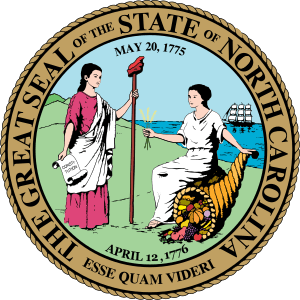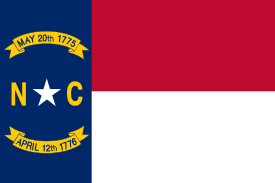Union County, North Carolina
Union County is a county located in the U.S. state of North Carolina. As of the 2010 census, the population was 201,292.[1] Its county seat is Monroe.[2]
Union County | |
|---|---|
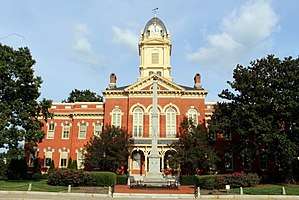 Union County Courthouse in 2017 | |
 Seal | |
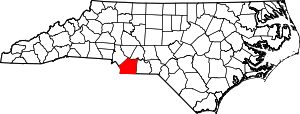 Location within the U.S. state of North Carolina | |
 North Carolina's location within the U.S. | |
| Coordinates: 34°59′N 80°32′W | |
| Country | |
| State | |
| Founded | 1842 |
| Seat | Monroe |
| Largest town | Indian Trail |
| Area | |
| • Total | 640 sq mi (1,700 km2) |
| • Land | 632 sq mi (1,640 km2) |
| • Water | 8.0 sq mi (21 km2) 1.3%% |
| Population | |
| • Estimate (2019) | 239,859 |
| • Density | 319/sq mi (123/km2) |
| Time zone | UTC−5 (Eastern) |
| • Summer (DST) | UTC−4 (EDT) |
| Congressional districts | 9th |
| Website | www |
Union County is included in the Charlotte-Concord-Gastonia, NC-SC Metropolitan Statistical Area.
History
The county was formed in 1842 from parts of Anson County and Mecklenburg County. Its name was a compromise between Whigs, who wanted to name the new county for Henry Clay, and Democrats, who wanted to name it for Andrew Jackson. The Helms, Starnes, McRorie, and Belk families were prominent in the town as well as Monroe and Charlotte. Most of these families came from Goose Creek Township.
Monroe, the county seat of Union County, also became a focal point during the Civil Rights Movement. In 1958, local NAACP Chapter President Robert F. Williams defended a nine-year-old African-American boy who had been kissed by a white girl in an incident known as the Kissing Case. A second African-American boy, aged seven, was also convicted and sentenced to live in a juvenile reformatory until he was 21 for simply witnessing the act. In 1961, Williams was accused of kidnapping an elderly white couple, when he sheltered them in his house during a very explosive situation of high racial tensions. Williams fled and went into exile in Cuba and in the People's Republic of China before returning to the United States.
Geography
According to the U.S. Census Bureau, the county has a total area of 640 square miles (1,700 km2), of which 632 square miles (1,640 km2) is land and 8.0 square miles (21 km2) (1.3%) is water.[3]
Adjacent counties
- Cabarrus County - north
- Stanly County - northeast
- Anson County - east
- Chesterfield County, South Carolina - southeast
- Lancaster County, South Carolina - southwest
- Mecklenburg County - northwest
Demographics
| Historical population | |||
|---|---|---|---|
| Census | Pop. | %± | |
| 1850 | 10,051 | — | |
| 1860 | 11,202 | 11.5% | |
| 1870 | 12,217 | 9.1% | |
| 1880 | 18,056 | 47.8% | |
| 1890 | 21,259 | 17.7% | |
| 1900 | 27,156 | 27.7% | |
| 1910 | 33,277 | 22.5% | |
| 1920 | 36,029 | 8.3% | |
| 1930 | 40,979 | 13.7% | |
| 1940 | 39,097 | −4.6% | |
| 1950 | 42,034 | 7.5% | |
| 1960 | 44,670 | 6.3% | |
| 1970 | 54,714 | 22.5% | |
| 1980 | 70,380 | 28.6% | |
| 1990 | 84,211 | 19.7% | |
| 2000 | 123,677 | 46.9% | |
| 2010 | 201,292 | 62.8% | |
| Est. 2019 | 239,859 | [4] | 19.2% |
| U.S. Decennial Census[5] 1790-1960[6] 1900-1990[7] 1990-2000[8] 2010-2014[1] | |||
As of the census[9] of 2010, there were 201,292 people, 67,864 households, and 54,019 families residing in the county. The population density was 194 people per square mile (75/km²). There were 45,695 housing units at an average density of 31.4 per square mile (12.3/km²). The racial makeup of the county was 79.0% White, 11.7% Black or African American, 0.4% Native American, 1.6% Asian, 0.03% Pacific Islander, 5.3% from other races, and 1.9% from two or more races. 10.4% of the population were Hispanic or Latino of any race.
There were 67,864 households out of which 42.1% had children under the age of 18 living with them, 64.60% were married couples living together, and 10.70% had a female householder with no husband present. 6.10% had someone living alone who was 65 years of age or older. The average household size was 2.94 and the average family size was 3.3.
In the county, the population was spread out with 32.90% under the age of 20, 4.7% from 20 to 24, 27.7% from 25 to 44, 25.2% from 45 to 64, and 9.6% who were 65 years of age or older. The median age was 36.2 years. The population was 49.4% male. Northern Union County has the southern foothills of the Uwharrie Mountains
Communities
City
- Monroe (county seat)
Towns
- Fairview (town)
- Hemby Bridge
- Indian Trail
- Marshville
- Mineral Springs
- Mint Hill
- Stallings
- Unionville
- Waxhaw
- Weddington
- Wingate
Villages
Census-designated place
Unincorporated communities
Ghost towns
Townships
- Goose Creek
- Jackson
- Marshville
- Monroe
- New Salem
- Vance
- Buford
- Lanes Creek
- Sandy Ridge
Politics, law and government
In the early twentieth century, Union County was typically firm "Solid South" Democratic apart from the 1928 election when anti-Catholicism reduced Al Smith's margin of victory in the county to only seven percentage points. Union County remained classically "Solid South" until after the Civil Rights Movement. The first Republican to win the county was Richard Nixon[10] with less than forty percent of the vote in a three-way race in 1968. Following Nixon's election, the trend towards liberalism in the Democratic Party has turned Union into a strongly Republican county over the past half-century. The last Democrat to win Union County was Jimmy Carter in 1980, and since then no Democrat has won more than 36 percent of the county's vote.
| Year | Republican | Democratic | Third parties |
|---|---|---|---|
| 2016 | 63.1% 66,707 | 32.5% 34,337 | 4.4% 4,666 |
| 2012 | 64.5% 61,107 | 34.3% 32,473 | 1.2% 1,148 |
| 2008 | 62.9% 54,123 | 36.2% 31,189 | 0.9% 777 |
| 2004 | 70.2% 42,820 | 29.5% 17,974 | 0.3% 207 |
| 2000 | 67.6% 31,876 | 31.6% 14,890 | 0.8% 395 |
| 1996 | 57.0% 18,802 | 35.0% 11,525 | 8.0% 2,643 |
| 1992 | 51.7% 16,542 | 33.7% 10,789 | 14.6% 4,661 |
| 1988 | 65.7% 17,015 | 34.1% 8,820 | 0.2% 61 |
| 1984 | 70.5% 16,885 | 29.4% 7,048 | 0.2% 35 |
| 1980 | 45.8% 9,012 | 51.2% 10,073 | 3.1% 603 |
| 1976 | 36.7% 6,184 | 62.8% 10,578 | 0.5% 78 |
| 1972 | 71.6% 10,264 | 27.1% 3,886 | 1.3% 186 |
| 1968 | 38.7% 5,290 | 26.5% 3,630 | 34.8% 4,761 |
| 1964 | 37.0% 4,229 | 63.0% 7,208 | |
| 1960 | 35.3% 4,030 | 64.7% 7,393 | |
| 1956 | 34.5% 3,362 | 65.5% 6,383 | |
| 1952 | 33.8% 3,790 | 66.2% 7,416 | |
| 1948 | 14.4% 738 | 66.2% 3,407 | 19.4% 999 |
| 1944 | 16.3% 1,114 | 83.7% 5,729 | |
| 1940 | 8.1% 634 | 91.9% 7,179 | |
| 1936 | 7.4% 601 | 92.6% 7,480 | |
| 1932 | 10.3% 710 | 88.8% 6,103 | 0.8% 57 |
| 1928 | 46.3% 2,448 | 53.7% 2,840 | |
| 1924 | 19.6% 672 | 79.5% 2,721 | 0.9% 32 |
| 1920 | 25.2% 1,404 | 74.8% 4,168 | |
| 1916 | 20.8% 702 | 79.0% 2,662 | 0.1% 4 |
| 1912 | 3.9% 92 | 75.9% 1,786 | 20.2% 476 |
Union County is a member of the regional Centralina Council of Governments.[12]
Education
- South Piedmont Community College
- Central Academy of Technology and Arts
- Cuthbertson High School
- Forest Hills High School
- Marvin Ridge High School
- Monroe Charter Academy
- Monroe High School
- Parkwood High School
- Piedmont High School
- Porter Ridge High School
- Sun Valley High School
- Arborbrook Christian Academy
- Tabernacle Christian School
- Union County Early College
- Union Academy
- Weddington High School
- Wingate University
- Shiloh Elementary
Events
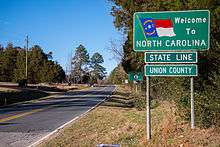
- Brooklandwood in Mineral Springs is the site of the Queens Cup Steeplechase, one of steeplechase horse racing's major annual events. The program consists of several races, and is held the last Saturday of April. The schedule of events also features a Jack Russell Terrier judging contest. Over 10,000 people typically attend the event.
- The Union County town of Marshville is the site of the Boll Weevil Festival, an annual street fair and carnival that takes place every fall.
See also
References
- "State & County QuickFacts". United States Census Bureau. Retrieved October 30, 2013.
- "Find a County". National Association of Counties. Retrieved 2011-06-07.
- "2010 Census Gazetteer Files". United States Census Bureau. August 22, 2012. Archived from the original on January 12, 2015. Retrieved January 20, 2015.
- "Population and Housing Unit Estimates". Retrieved March 28, 2020.
- "U.S. Decennial Census". United States Census Bureau. Retrieved January 20, 2015.
- "Historical Census Browser". University of Virginia Library. Retrieved January 20, 2015.
- Forstall, Richard L., ed. (March 27, 1995). "Population of Counties by Decennial Census: 1900 to 1990". United States Census Bureau. Retrieved January 20, 2015.
- "Census 2000 PHC-T-4. Ranking Tables for Counties: 1990 and 2000" (PDF). United States Census Bureau. April 2, 2001. Retrieved January 20, 2015.
- "U.S. Census website". United States Census Bureau. Retrieved 2008-01-31.
- Menendez, Albert J.; The Geography of Presidential Elections in the United States, 1868-2004, pp. 95-96 ISBN 0786422173
- Leip, David. "Dave Leip's Atlas of U.S. Presidential Elections". uselectionatlas.org. Retrieved 2018-03-17.
- "Centralina Council of Governments". Retrieved August 10, 2019.

